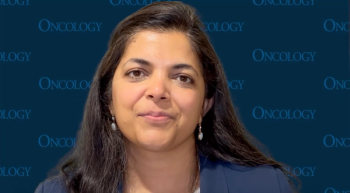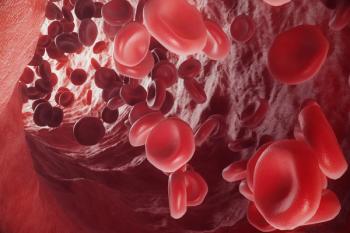
Oncology NEWS International
- Oncology NEWS International Vol 8 No 2
- Volume 8
- Issue 2
Studies Explore Roles of Chemotherapy and Radiotherapy in Hodgkin’s Disease
MIAMI BEACH-Hodgkin’s disease (HD) was the focus of an education session and major new research reports at the American Society of Hematology annual meeting. Among the conclusions: Neoadjuvant chemotherapy before radiotherapy provides better outcomes in early-stage HD; moderate dose escalation offers some advantages in advanced disease; and chemotherapy is equal to radiotherapy as consolidation treatment in advanced disease.
MIAMI BEACHHodgkins disease (HD) was the focus of an education session and major new research reports at the American Society of Hematology annual meeting. Among the conclusions: Neoadjuvant chemotherapy before radiotherapy provides better outcomes in early-stage HD; moderate dose escalation offers some advantages in advanced disease; and chemotherapy is equal to radiotherapy as consolidation treatment in advanced disease.
Neoadjuvant Chemotherapy
An interim analysis from the German Hodgkins Lymphoma Study Group HD7 trial found that two cycles of ABVD plus radiotherapy is more effective than radiotherapy alone in early-stage HD. Two cycles of ABVD prior to extended-field radiotherapy reduces the relapse rate and improves the time to treatment failure, Hans Tesch, MD, of the University of Cologne, reported for the investigators.
Dr. Tesch said that extended-field radiotherapy produces complete remissions in more than 90% of patients with early-stage HD, but that up to 25% eventually relapse and require intensive chemotherapy. This trial was undertaken to determine whether low-dose neoadjuvant chemotherapy could reduce the risk of relapse.
The trial included 640 patients with stage I or II Hodgkins disease who did not have poor prognostic factors (large mediastinal mass, massive spleen involvement, extranodal disease, elevated ESR, more than 3 lymph node areas).
Patients were randomized to receive either extended-field radiotherapy with 30 Gy, plus involved-field radiation of 40 Gy and spleen radiation of 36 Gy, or two cycles of ABVD (doxorubicin, bleomycin, vindesine, dacarbazine) followed by the same radiotherapy schedule.
The median follow-up of this interim analysis was 28 months and included 365 patients. The complete response rate was 96% with radiotherapy alone and 98% with ABVD plus radiotherapy.
Kaplan-Meier estimates of freedom from treatment failure showed a significant difference in favor of ABVD plus radiotherapy (87% vs 96% at 24 months, P < .05). The difference is due mainly to the reduction in the number of relapses with combination therapy (9% vs 1%). Survival rates are not different at 24 months (97% vs 98%). There were seven deaths in each treatment arm.
Acute toxicities were rare on both treatment arms, but Dr. Tesch said that 11% of patients on the ABVD/radiotherapy arm developed leukopenias.
Dr. Tesch concluded, The interim analysis demonstrates that neoadjuvant chemotherapy with two cycles of ABVD significantly reduces the rate of relapse and improves the time to treatment failure. Current trials with combined modality therapy aim to reduce acute and long-term toxicities by reducing radiotherapy dose and volume.
Moderate Dose Escalation
At least 40% of patients with advanced stage HD will eventually have disease recurrence or progression. Volker Diehl, MD, reporting a second interim analysis for the German Hodgkins Lymphoma Study Group HD9 trial, said that moderate chemotherapy dose escalation improves time to progression in advanced-stage Hodgkins disease.
Dr. Diehl reported data from 689 evaluable patients randomized to receive COPP/ABVD as standard therapy, BEACOPP (bleomycin, etoposide, doxorubicin, cyclophosphamide, vincristine, procarbazine, prednisone), or escalated BEACOPP with G-CSF support.
Baseline BEACOPP was approximately equivalent in dosage to COPP/ABVD but shortened to a 3-week course. On the escalated arm, compared with standard BEACOPP, doses were escalated to 192% cyclophosphamide, 200% etoposide, and 140% doxorubicin.
Dr. Diehl said that etoposide, doxorubicin, and cyclophosphamide were given on days 1 to 3 and repeated on day 21 in order not to give the cells time to develop resistance. The standard COPP/AVBD arm was stopped early on in the study.
The study enrolled 1,055 patients between 15 and 65 years of age with either stage IIB/IIIA disease with risk factors or stage IIIB/IV disease. Eight courses of chemotherapy were followed by local irradiation of initial bulky and residual disease. Median observation time was 27 months.
Acute toxicity (neutropenia, thrombocytopenia, anemia, infection) under BEACOPP was increased but manageable; toxic deaths were not more frequent than for COPP/ABVD. Progressive HD accounted for 11 of 29 deaths on standard therapy, 9 of 17 deaths on BEACOPP, and 1 of 9 deaths on escalated BEACOPP.
Long-term toxicity remains a problem, Dr. Diehl said, particularly with regard to myelodysplasia, secondary acute myelogenous leukemia (AML), or other secondary malignancies (see Table).
RT vs Chemo as Consolidation
Another approach in advanced-stage Hodgkins disease is to use radiotherapy rather than chemotherapy as consolidation therapy.
Christophe Fermé, MD, reporting for the Groupe dEtude des Lymphomes de lAdulte (GELA), Hôpital Saint-Louis, Paris, France, said that these two approaches produced essentially the same results in stage IIIB-IV Hodgkins disease in first complete remission or good partial response. There were no significant differences in either overall survival or 5-year event-free survival in this study.
The 559 patients in this study were randomized at diagnosis to receive six cycles of ABVPP (doxorubicin, bleomycin, vinblastine, procarbazine, prednisone) or MOPP/ABV hybrid.
Patients in complete response or 75% partial response after six cycles were then randomized to receive either two additional cycles of the same regimen or radiotherapy. This included subtotal or total nodal irradiation of 30 Gy, plus 5 Gy to the initially involved areas and 5 Gy to the residual mass.
Dr. Fermé said that at a median follow-up of 46 months, 152 patients (28%) had progressed and 90 had died, 43 of HD and 47 of other causes, including seven solid tumors, five non-Hodgkins lymphomas, and one AML. Three other patients developed secondary AML and are alive without Hodgkins disease.
He concluded that chemotherapy alone allows the same survival or a better survival than chemotherapy plus radiotherapy but that a longer follow-up, analysis of fatal events, and analysis of salvage from relapse after radiotherapy will be required to give definitive conclusions about these two approaches to consolidation.
Articles in this issue
almost 27 years ago
Paclitaxel Plus Mitoxantrone for Poor-Prognosis Breast Canceralmost 27 years ago
Faslodex, Pure Antiestrogen, Studied in Tamoxifen-Resistant Breast Canceralmost 27 years ago
LHRH Agonist Plus Tamoxifen Improves Outcome in Young Metastatic Patientsalmost 27 years ago
Pros and Cons of Different Approaches to Chemoradiationalmost 27 years ago
Less Cardiotoxicity With Liposomal Doxorubicinalmost 27 years ago
Optimizing Docetaxel Tolerability in Anthracycline-Resistant Breast Canceralmost 27 years ago
Doxorubicin Appears to Change Natural History of HER-2+ Cancer’salmost 27 years ago
Tamoxifen After Surgery/RT Decreases Local Recurrence Risk in DCIS PatientsNewsletter
Stay up to date on recent advances in the multidisciplinary approach to cancer.
















































































